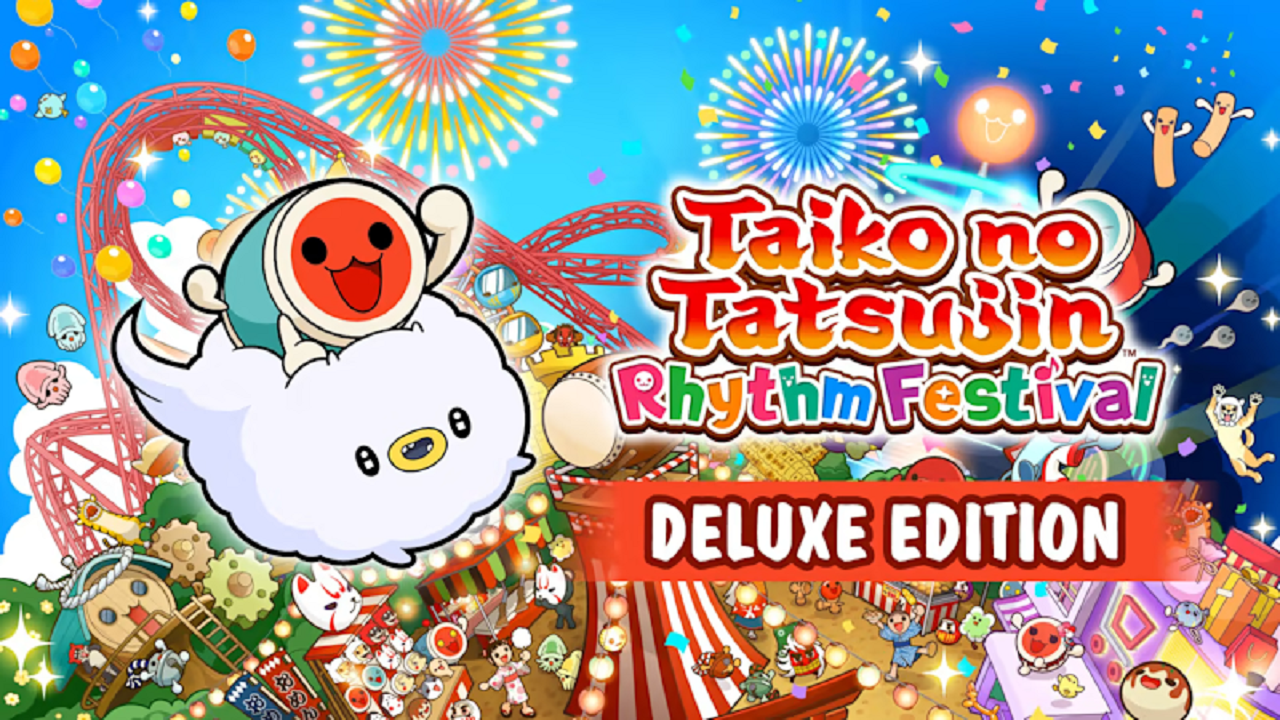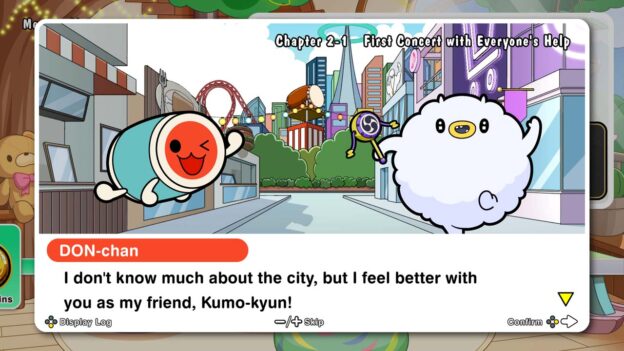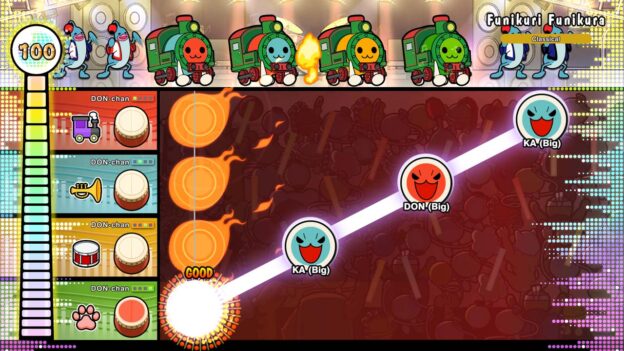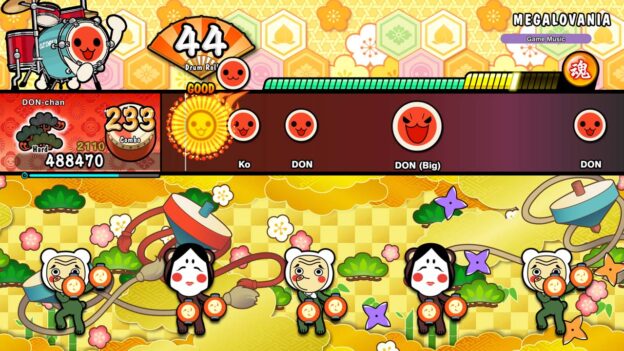“I’ve got blisters on my fingers!”
Taiko no Tatsujin: Rhythm Festival is the latest game in the 20-year music-rhythm series. While mainly known to Japanese players, there have been titles localized on Nintendo Switch. Have I mastered the drums in my introduction to the series? Nope, but I’m having fun with Rhythm Festival.
I admit to feeling a tad overwhelmed initially. Well, to the extent one can feel overwhelmed by an E-rated music video game. I won’t say navigation is a pain, but it took me some time to figure out the various menus and submenus. Learning the general and overall layout, what’s what in Oniko City, where the titular Rhythm Festival is taking place, was my first task.
As the center icon (and the largest one), Taiko mode is where I began. Here you and an optional friend can get straight into drumming. There are over 70 songs “available at launch,” and that wording makes me suspect freebies will come down the line. There are also paid songs via the Taiko music pass, a whopping 500-plus available either monthly at $3.99 or quarterly at $9.99. Individual song packs are available for purchase, too, a limited selection at 4 or 5 bucks a pop. Unfortunately, these aren’t compatible with the earlier Switch release, although there are other perks for owners. A Deluxe Edition of the game gives you three months for only 5 dollars more.
Music is as subjective as it comes, but Rhythm Festival has good diversity with plenty of catchy songs to appeal to varied tastes. Even tunes you think wouldn’t work being drummed can pull it off effectively. You can sort the various categories and genres (all color coded for easy navigation). Some choices are anime, classical, pop, and many Namco originals. FYI, more than half of the Vocaloid consists of Hatsune Miku.
With four difficulties, anyone can jump right in, and I’m grateful for that; you can move online if/when you feel confident. I recommend starting with songs you know to help find your rhythm. But you’ll see your combos grow as you learn and click with all the various tunes. It’s rewarding mastering individual songs and getting in the groove.
Doddoko Town is all about playing online (if you’ve subscribed to Nintendo Switch Online). Having to flip through 18 pages of explanation, though, is another instance of menus feeling overly complicated for what should be pretty straightforward processes. After a long search for an opponent, I found one who promptly bested me. The game said they were “just a bit better,” which I’m sure they feel is polite but is dishonest; I got soundly beat. I tried this mode just to test it (I much prefer local play). But for those who plan to spend the bulk of their time online, make sure you keep your Switch subscription up to date, have high-speed internet, and have lots of practice.
Taiko Land has a pair of party games that are admittedly not that dissimilar to the base game. Up to four friends can join you cooperatively as part of a band, which is good fun. Don’t worry; ai can round out the ensemble if you’re short on friends. How many concert fans will you get? The other has you competing with toys, which sounds odd but fits the style. A mission-based mode with a bit of a puzzle angle, you can top your opponent by speeding up their notes, inserting fake ones, and other such trickery. You can also play this mode online.
The store, where you can purchase hats, suits, and even mini characters to accompany Don-Chan, the quirky anthropomorphic lead from Drum World. Seeing Kirby hang off his back is pretty darn cool! The in-game currency is an effective replay incentive, sure to drive completionists to buy everything available.
Your room lets you change into outfits and look at your numerous trophies. You’ll earn many just by trying modes for the first time. Also, much-appreciated control settings are here. Want to play with traditional setups? You can, with three different button layout types available. Motion controls are also available, of which I’m a fan. I found them A-Okay for the move sets, at least on the lower difficulties. Just make sure you have the straps secured around your wrists.
I was kindly sent a Taiko no Tatsujin: Rhythm Festival drum accessory also, which immerses even more than the motion controls. Much like in games like Rock Band, this plastic accessory adds a layer of fun. If you think you’ll be investing a fair amount of time in this game, you may want to invest in this, too.
Taiko no Tatsujin: Rhythm Festival presents a shiny and vivid world. With so much zany animation, it’s almost as fun to watch as it is to play. Just be sure not to let it distract you. There’s a real charm on display, and the visual variety happily meshes well with the music.
Perhaps my only issue of note is some peculiarities with scoring. I noticed when competing against my wife she bested me. Yet I had more “good” notes, fewer “bad” ones, and higher combos, drumrolls, and percentages. Granted, I’m more about co-op, but for the competitive, take note that something is off.
While those more familiar with the series might have some gripes, Taiko no Tatsujin: Rhythm Festival was an excellent introduction for me. No worries about being overly skilled at these types of games; you’ll have a good time, especially if you have friends in the room for a party-type setting. But even more solo gamers will have the main story and many unlockables to keep them busy. Whether competing or cooperating, this could be a ton of fun for family gatherings.
Review: Taiko no Tatsujin: Rhythm Festival (Nintendo Switch)
Great
While those more familiar with the series might have some gripes, Taiko no Tatsujin: Rhythm Festival was an excellent introduction for me. No worries about being overly skilled at these types of games; you’ll have a good time, especially if you have friends in the room for a party-type setting. But even more solo gamers will have the main story and many unlockables to keep them busy. Whether competing or cooperating, this could be a ton of fun for family gatherings.







